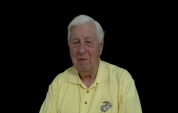5:35 | The food on the LST was meager, so when Bill Richardson got to Hawaii, a simple treat felt like a lot more. His first assault was at Roi-Namur in the Marshall Islands. It wasn't what he expected and that was a good thing. (This interview made possible with the support of JOHN R. ASMUS.)
Keywords : Bill Richardson artillery Kauai Hawaii ice cream Landing Ship Tank (LST) Roi-Namur Marshall Islands Maui Japanese archipelago atoll Attack Transport (APA)

If Bill Richardson had failed the physical examination, several of his buddies would have failed, too. The reason would have made that somewhat embarrassing. They were only taking five men for the Marines that day and he was the fifth, so his buddy from back home had to settle for the Navy. (This interview made possible with the support of JOHN R. ASMUS.)
Before he left for boot camp, Bill Richardson got what he thought was a short haircut. Not short enough as it turned out. He didn't have any trouble getting up in the morning, which saved him some trouble. As a Marine, he knew he would have to qualify on the rifle range. Not qualifying would have been unthinkable. (This interview made possible with the support of JOHN R. ASMUS.)
After basic training, it was off to Quantico for artillery school. Bill Richardson learned every job on the guns and then it was time for a train ride to California. The Marines had it better than the Army on that trip, at least at lunch time. The last training before deployment took place off the coast at San Diego. (This interview made possible with the support of JOHN R. ASMUS.)
It was a small, uncomfortable ship, an LST. Bill Richardson remembers how the trip to Hawaii turned into an ordeal once the convoy was hit by a huge storm. Two burials at sea focused his mind pretty well. (This interview made possible with the support of JOHN R. ASMUS.)
As Bill Richardson was preparing for the Saipan and Tinian operation, he witnessed the West Loch incident in Pearl Harbor. A number of ships exploded while at anchor. What could have caused this? (This interview made possible with the support of JOHN R. ASMUS.)
There was only light resistance going into Saipan for Bill Richardson and his Marine artillery battery. The island was much different than the tropical paradise he found in the Marshall Islands. There was jungle and there were Japanese batteries firing back at him. (This interview made possible with the support of JOHN R. ASMUS.)
From the information they had and the mock-up of the island they saw, the Marines figured Iwo Jima would be an easy operation. Bill Richardson went ashore with his artillery battery as soon as they could get on the crowded beach. It was immediately apparent that it was going to be a monumental battle. Part 1 of 3. (This interview made possible with the support of JOHN R. ASMUS.)
The Japanese were so well dug in on Iwo Jima that the field artillery couldn't get to them. The flag had been raised on Mt. Suribachi but there was a long way to go to secure the island. When he wasn't wondering where the Japanese rounds were going to land, Bill Richardson had to deal with the cold, wet conditions. Part 2 of 3. (This interview made possible with the support of JOHN R. ASMUS.)
They were beat up. They were tired. They were dirty. The Marine artillery unit had spent weeks in the misery of Iwo Jima and they were now heading for some rest, but there was one problem. Their transport was a Merchant Marine vessel and their treatment was not what they deserved. Part 3 of 3. (This interview made possible with the support of JOHN R. ASMUS.)
Bill Richardson was training in Hawaii for the final assault, Japan. Then came the great news about the atomic bomb. He could go the other direction across the Pacific. (This interview made possible with the support of JOHN R. ASMUS.)